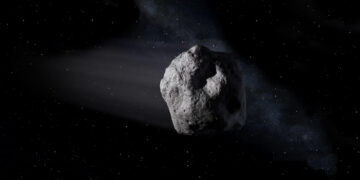In a universe brimming with celestial wonders, few discoveries challenge our understanding of space like 2060 Chiron. Classified as a centaur—a celestial hybrid named after the mythological creature—Chiron exhibits traits of both an asteroid and a comet. Discovered in 1977, this enigmatic object orbits the Sun once every 50 years, bridging the gap between the gas giants Jupiter and Neptune.
What is 2060 Chiron?
Chiron represents a rare category of celestial bodies known as centaurs, characterized by their dual nature as both asteroid-like and comet-like objects. Found in the cold reaches of space between Jupiter and Neptune, Chiron has intrigued scientists for decades due to its unusual composition. Unlike traditional asteroids, Chiron features a solidified icy exterior and emits gases from an internal coma, akin to a comet.
First identified in 1977, Chiron has since been a focal point of research for its unique properties. The name “centaur” aptly captures its duality, mirroring its mythological namesake—a creature part human, part horse. This hybrid identity has raised questions about Chiron’s origin, evolution, and the processes shaping celestial objects in the outer solar system.
The Recent Breakthroughs
The James Webb Space Telescope has revolutionized our ability to study distant celestial objects, and Chiron is no exception. Utilizing JWST’s advanced capabilities, researchers have observed gases such as carbon dioxide and methane emanating from Chiron’s interior, providing direct evidence of its active coma. These primordial gases are believed to date back billions of years, potentially predating the formation of the Sun.
Charles Schambeau, a researcher leading the study, described Chiron as an “oddball” centaur whose behavior defies conventional expectations. “These detections enhance our understanding of Chiron’s interior composition and how that material produces the unique behaviors as we observe Chiron,” he explained.
The Science Behind Chiron’s Hybrid Nature
Chiron’s dual nature stems from its unique composition and location within the solar system. As an asteroid, it possesses a solid structure, but as a comet, it features volatile materials that sublimate, forming a glowing coma. This combination makes Chiron a rare specimen for scientists seeking to understand the dynamics of small celestial bodies.
The detection of gases like carbon dioxide and methane supports the theory that Chiron retains primordial material from the early solar system. This material provides a window into the conditions present during the formation of the Sun and planets. Unlike other objects in the same region, Chiron’s hybrid traits offer a unique perspective on the interplay between heat, ice, and gas in shaping celestial bodies.
Implications for Solar System Studies
Chiron’s study holds immense implications for our understanding of the solar system’s history. By analyzing its composition, scientists can infer details about the early solar system, particularly the distribution of ices and volatiles.
Moreover, the presence of gases within Chiron’s coma suggests that similar celestial bodies could harbor volatile materials capable of influencing planetary systems. Understanding the behavior of centaurs like Chiron could offer clues about the origins of water and other essential compounds on planets like Earth.
Future Plans and Research Directions
As Chiron approaches closer to the Sun and Earth, researchers plan to conduct further studies to refine their understanding of its behavior. The goal is to measure the quantities and types of ices present, shedding light on the mechanisms driving its activity.
Why This Matters
The study of Chiron is not merely an exercise in curiosity; it is a vital step toward unraveling the mysteries of our cosmic origins. As a hybrid celestial body, Chiron challenges traditional classifications and compels scientists to reconsider the boundaries between asteroids and comets. Its behavior and composition serve as a time capsule, preserving clues about the conditions that shaped the early solar system.
Furthermore, the ability of the JWST to analyze such distant objects underscores the importance of advancing astronomical technology. These tools not only expand our understanding of the universe but also inspire new questions about the nature of celestial bodies and the forces that govern them.
Conclusion
2060 Chiron stands as a testament to the complexity and wonder of the cosmos. With its dual identity as both asteroid and comet, it offers a unique opportunity to explore the processes that have shaped our solar system. The insights gained from Chiron’s study are a reminder of the transformative power of modern astronomy and its ability to reveal the hidden secrets of the universe. As research continues, Chiron may yet unlock answers to some of the most profound questions about our place in the cosmos.



















